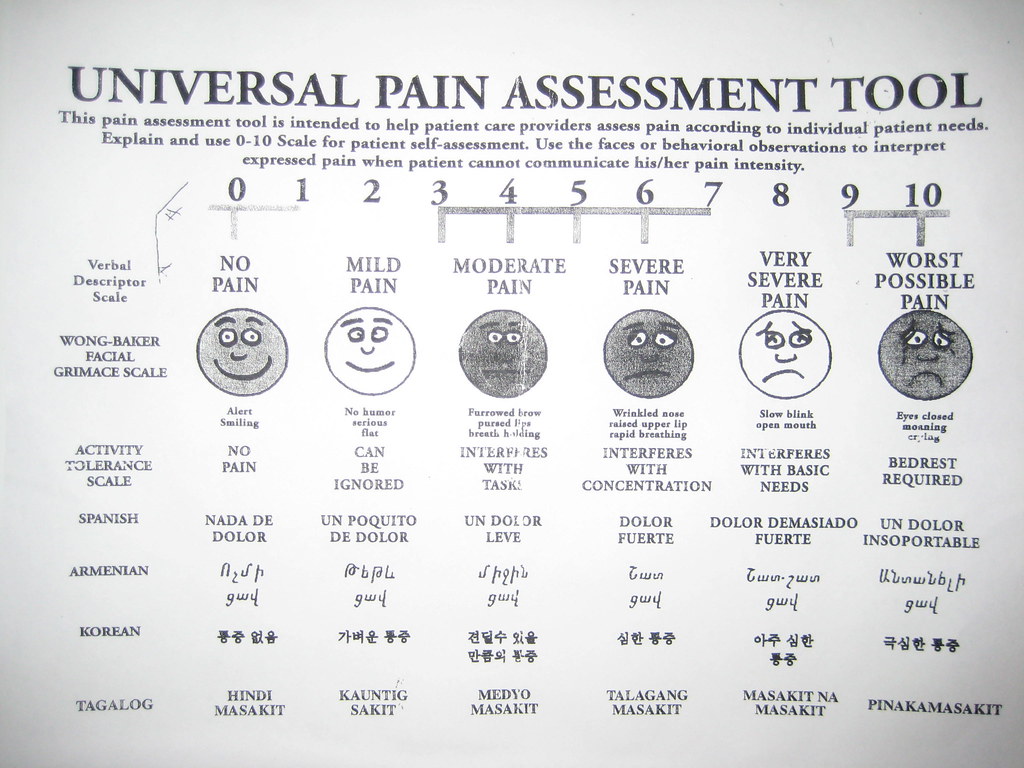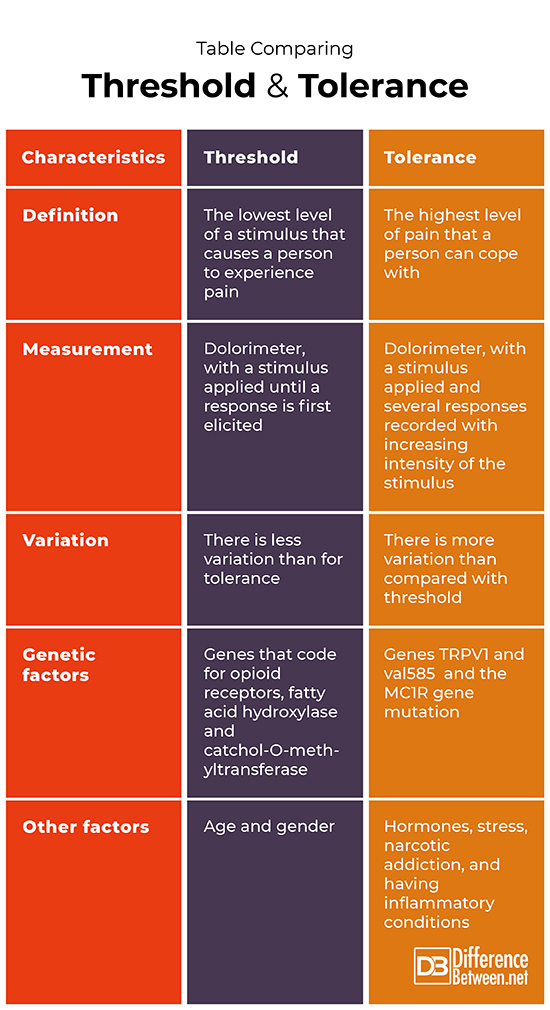Difference Between Threshold and Tolerance
Threshold is the level at which a stimulus first causes a person to feel pain. Tolerance is the maximum amount of pain a person is able to cope with.

What is Threshold?
Definition:
The pain threshold is the particular level at which a stimulus causes a person to start to experience pain. The threshold will vary depending on what the stimulus is; for instance, there will be different pain threshold values for temperature and pressure.
Measurement:
A person’s threshold to pain can be measured using an instrument known as a dolorimeter. Pressure, temperature or electrical signals are often used as the stimulus and the pain level recorded. The minimum stimulus to cause pain would be the pain threshold.
Genetic factors influencing pain threshold:
The pain threshold is influenced by genetics; researchers have found polymorphisms in particular genes that play a role in influencing the threshold. The genes discovered to impact threshold include those that code for transient receptor potential A subtype 1 channels, fatty acid hydroxylase, opioid receptors, and catechol-O-methyltransferase,
Other factors influencing pain threshold:
Other factors also impact what a person’s pain tolerance is; age is one such example. Children have a low pain threshold compared to adults but the threshold changes as they grow older. Gender is also a factor, with females having a lower threshold, possibly for evolutionary reasons or due to biological factors. Pain threshold does not vary as much among people as does tolerance to pain.

What is Tolerance?
Definition:
Pain tolerance describes the highest levels of pain a person can tolerate. This is quite variable from one individual to another, for a particular painful stimulus.
Measurement:
Tolerance to painful stimuli can be measured using a dolorimeter and adjusting the intensity of stimuli to reach a maximum level, which would be the tolerance level. As a stronger stimulus is applied, the subject’s response is noted. It is easy to confuse this with threshold, especially since both use the same type of measuring instrument, but threshold is the lowest value while tolerance is the highest value related to the painful stimulus.
Genetic factors influencing pain tolerance:
Genetic factors as well as psychological and social factors can all influence how tolerant a person is to pain. People with red hair have a MC1R gene mutation that is also linked to a lowered tolerance for pain, and thus often they need more medication. Scientists do not fully understand the reason why this genetic mutation is linked to pain because it is related to melanin production in the body. The genes TRPV1 and val585 are associated with higher tolerance to cold; however this is only the case for people who are homozygous for these genes.
Other factors influencing pain tolerance:
Lifestyle factors also impact tolerance, and in fact, people who have inflammatory conditions often sleep poorly and have problems with pain tolerance, even when inflammation is reduced. Unfortunately individuals addicted to narcotics often display a decrease in pain tolerance due to changes in brain chemistry induced by drugs. Hormones and stress also impact the pain tolerance, with higher levels of epinephrine resulting in a lower pain tolerance.
Difference between Threshold and Tolerance?
Definition
Threshold is the lowest level of a stimulus that causes a person to experience pain. Tolerance is the highest level of pain that a person can cope with.
Measurement
A dolorimeter is used to measure pain threshold and a stimulus is applied until the person first shows a response, which is then taken as the threshold. A dolorimeter is also used to measure pain tolerance, but in this case several responses are noted as the stimulus increases with intensity, until the highest value is obtained, which is then taken as the tolerance.
Variation
There is less variation in values of pain threshold for a particular stimulus compared with pain tolerance. There is more variation in values of pain tolerance for a particular stimulus compared with pain threshold.
Genetic factors
Threshold is influenced by the genes that code for opioid receptors, fatty acid hydroxylase, and catechol-O-methyltransferase. Tolerance is influenced by the genes TRPV1 and val585, as well as the MC1R gene mutation.
Other factors
Two other important factors impacting pain threshold are the age and gender of a person. Other factors impacting pain tolerance include the following: hormones, stress, narcotic addiction, and also having inflammatory conditions.
Table comparing Threshold and Tolerance

Summary of Threshold Vs. Tolerance
- Both threshold and tolerance are terms commonly used to describe pain.
- Pain threshold refers to the lowest level of a painful stimulus that triggers a response from the individual.
- Pain tolerance is how much pain a person can actually tolerate, so it is a higher value compared with pain threshold.
- Threshold and tolerance are both attributes of pain that are measured with an instrument called a dolorimeter.
- Genetic factors have been shown to be important when it comes to both tolerance and threshold values for people.
- Pain thresholds are also less variable than tolerances when looking at the values among a group of people.
- Difference Between Rumination and Regurgitation - June 13, 2024
- Difference Between Pyelectasis and Hydronephrosis - June 4, 2024
- Difference Between Cellulitis and Erysipelas - June 1, 2024
Search DifferenceBetween.net :
Leave a Response
References :
[0]Hogeweg, J. A., et al. "Algometry. Measuring pain threshold, method and characteristics in healthy subjects." Scandinavian Journal of Rehabilitation Medicine 24.2 (1992): 99.
[1]Kim, H., et al. "Genetic predictors for acute experimental cold and heat pain sensitivity in humans." Journal of medical genetics 43.8 (2006): e40-e40.
[2]Lee, Yvonne C., et al. "The role of sleep problems in central pain processing in rheumatoid arthritis." Arthritis & Rheumatism 65.1 (2013): 59-68.
[3]Image credit: https://live.staticflickr.com/2467/3881981855_7ab2b45f2e_b.jpg
[4]Image credit: https://upload.wikimedia.org/wikipedia/commons/5/5e/Loudness_of_common_sounds.jpg
